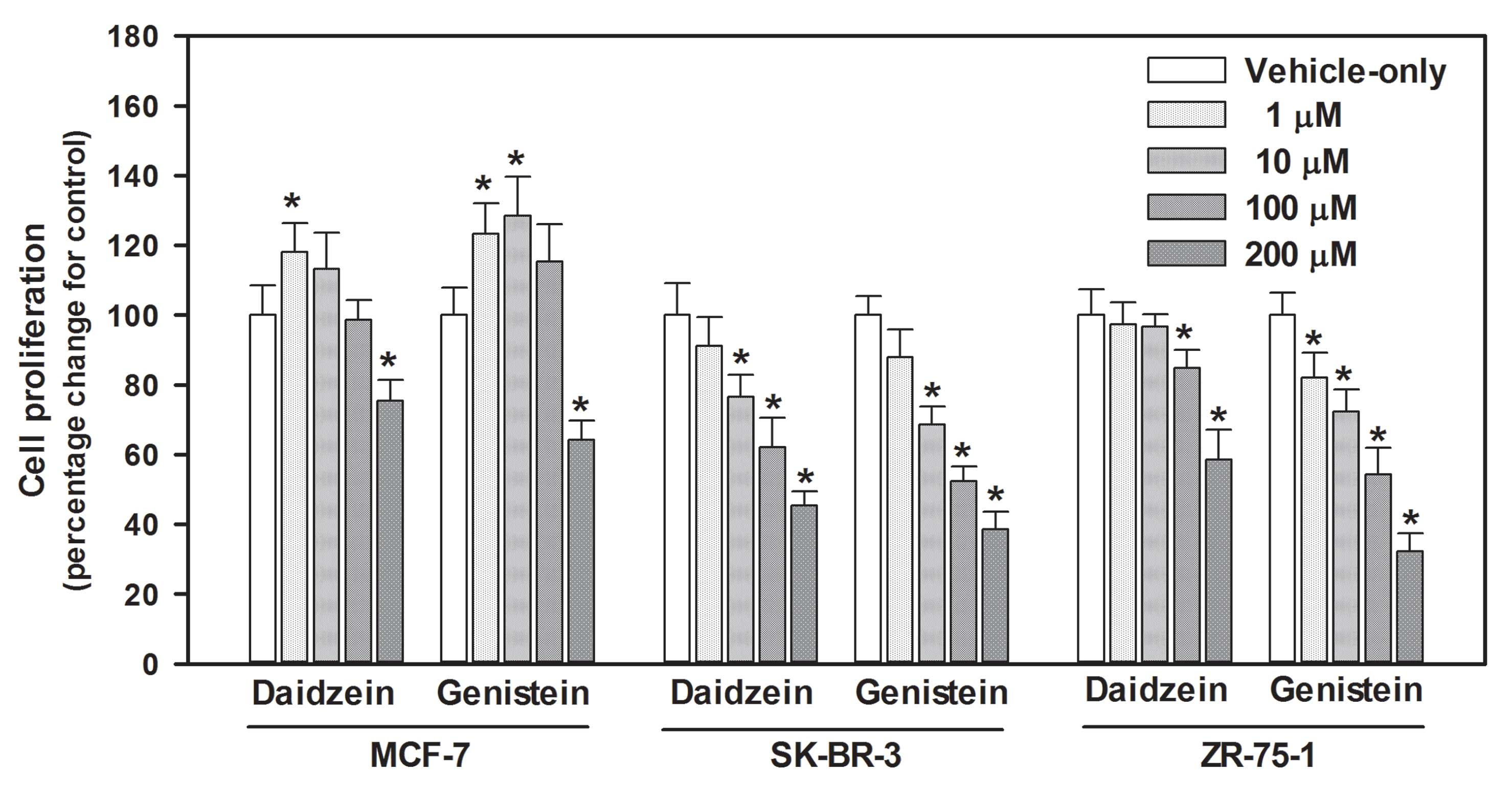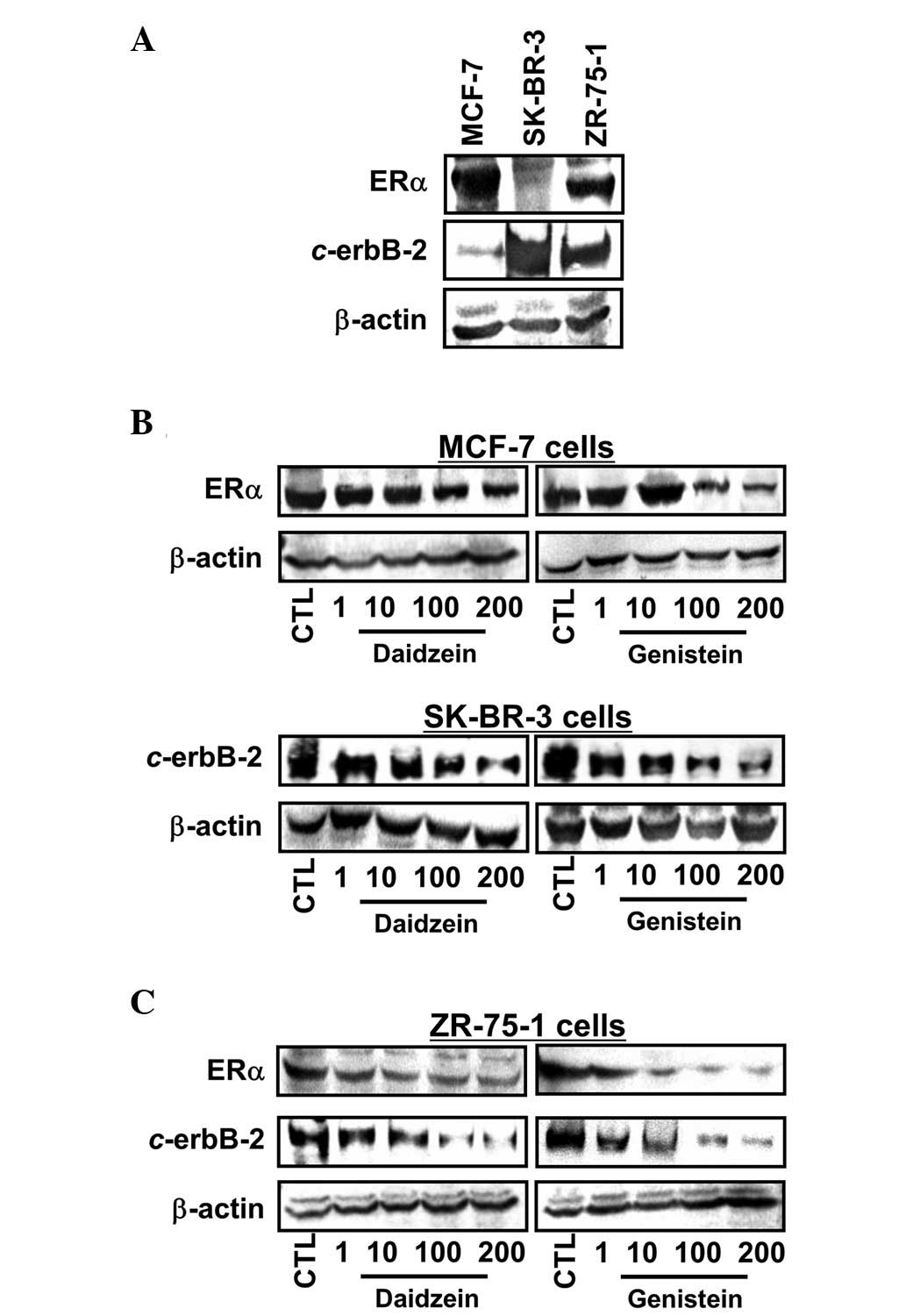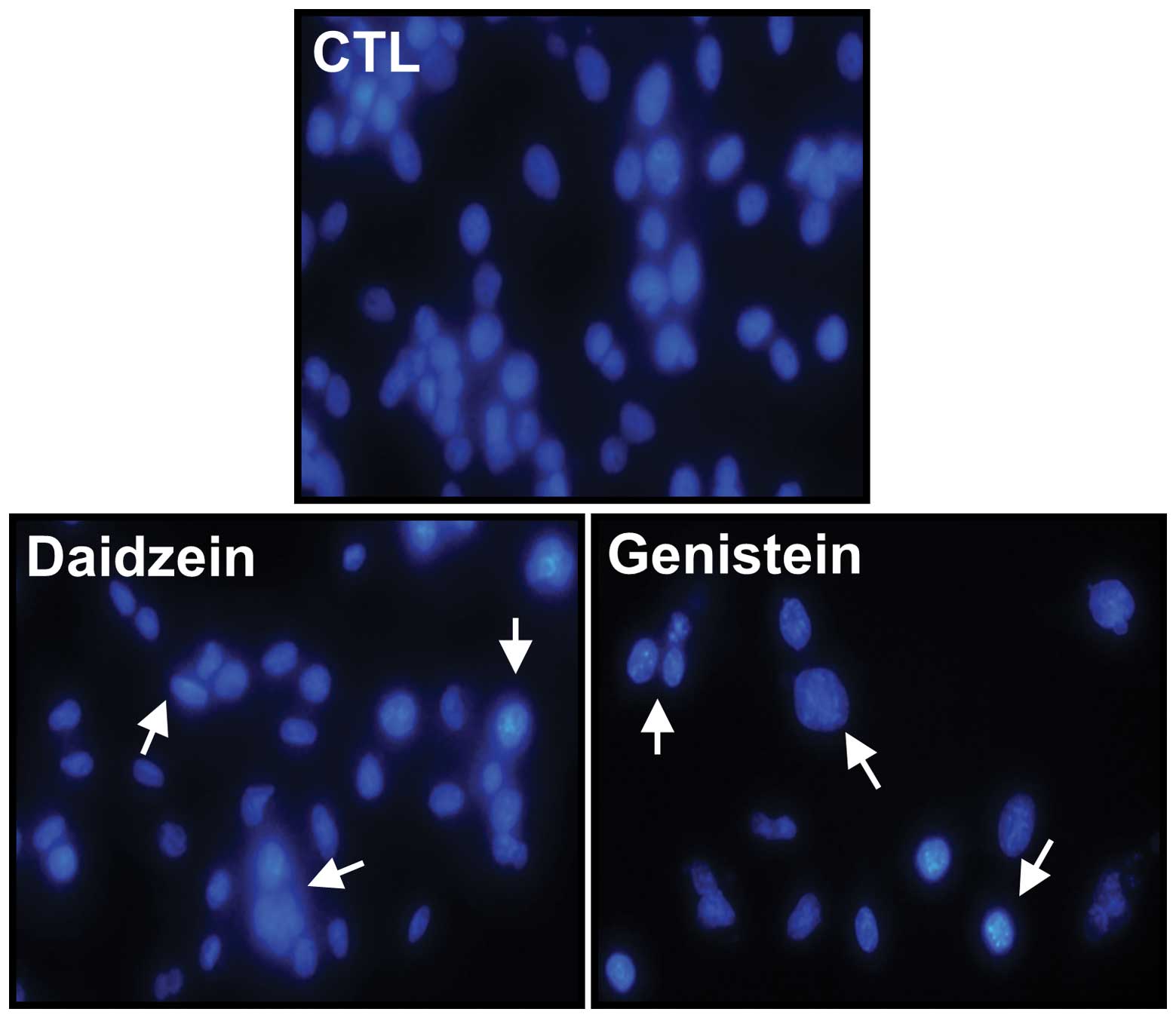|
1
|
Liggins J, Bluck LJ, Runswick S, et al:
Daidzein and genistein contents of vegetables. Br J Nutr.
84:717–725. 2000.PubMed/NCBI
|
|
2
|
Liggins J, Bluck LJ, Runswick S, et al:
Daidzein and genistein content of fruits and nuts. J Nutr Biochem.
11:326–331. 2000. View Article : Google Scholar : PubMed/NCBI
|
|
3
|
Iwasaki M, Inoue M, Otani T, et al: Plasma
isoflavone level and subsequent risk of breast cancer among
Japanese women: a nested case-control study from the Japan Public
Health Center-based prospective study group. J Clin Oncol.
26:1677–1683. 2008. View Article : Google Scholar
|
|
4
|
Lampe JW, Nishino Y, Ray RM, et al: Plasma
isoflavones and fibrocystic breast conditions and breast cancer
among women in Shanghai, China. Cancer Epidem Biomarkers Prev.
16:2579–2586. 2007. View Article : Google Scholar : PubMed/NCBI
|
|
5
|
Lu LJ, Anderson KE, Grady JJ, et al:
Decreased ovarian hormones during a soya diet: implications for
breast cancer prevention. Cancer Res. 60:4112–4121. 2000.PubMed/NCBI
|
|
6
|
Vissac-Sabatier C, Bignon YJ and
Bernard-Gallon DJ: Effects of the phytoestrogens genistein and
daidzein on BRCA2 tumor suppressor gene expression in breast cell
lines. Nutr Cancer. 45:247–255. 2003. View Article : Google Scholar : PubMed/NCBI
|
|
7
|
de Lemos ML: Effects of soy phytoestrogens
genistein and daidzein on breast cancer growth. Ann Pharmacother.
35:1118–1121. 2001.PubMed/NCBI
|
|
8
|
Pugazhendhi D, Watson KA, Mills S, et al:
Effect of sulphation on the oestrogen agonist activity of the
phytoestrogens genistein and daidzein in MCF-7 human breast cancer
cells. J Endocrinol. 197:503–515. 2008. View Article : Google Scholar : PubMed/NCBI
|
|
9
|
Choi EJ and Kim GH: Hepatoprotective
effects of daidzein against 7,12-dimetylbenz[a]anthracene-induced
oxidative stress in mice. Int J Mol Med. 23:659–664.
2009.PubMed/NCBI
|
|
10
|
Choi EJ and Lee BH: Evidence for genistein
mediated cytotoxicity and apoptosis in rat brain. Life Sci.
75:499–509. 2004. View Article : Google Scholar : PubMed/NCBI
|
|
11
|
Choi EJ, Kim T and Lee MS: Pro-apoptotic
effect and cytotoxicity of genistein and genistin in human ovarian
cancer SK-OV-3 cells. Life Sci. 80:1403–1408. 2007. View Article : Google Scholar : PubMed/NCBI
|
|
12
|
Choi EJ and Kim GH: Daidzein causes cell
cycle arrest at the G1 and G2/M phases in human breast cancer MCF-7
and MDA-MB-453 cells. Phytomedicine. 15:683–690. 2008. View Article : Google Scholar : PubMed/NCBI
|
|
13
|
National Breast Cancer Foundation.
http://www.nationalbreastcancer.org/about-breast-cancer/breast-cancer-symptoms.
Accessed, March 2011
|
|
14
|
National Cancer Institute. SEER Cancer
Statistics Review, 1975–2002. http://seer.cancer.gov/csr/1975_2002/.
Accessed, March 2005
|
|
15
|
Guo JM, Xiao BX, Liu DH, et al: Biphasic
effect of daidzein on cell growth of human colon cancer cells. Food
Chem Toxicol. 42:1641–1646. 2004. View Article : Google Scholar : PubMed/NCBI
|
|
16
|
El Touny LH and Banerjee PP:
Identification of a biphasic role for genistein in the regulation
of prostate cancer growth and metastasis. Cancer Res. 69:3695–3703.
2009.PubMed/NCBI
|
|
17
|
Hsu JT, Hung HC, Chen CJ, et al: Effects
of the dietary phytoestrogen biochanin A on cell growth in the
mammary carcinoma cell line MCF-7. J Nutr Biochem. 10:510–517.
1999. View Article : Google Scholar : PubMed/NCBI
|
|
18
|
Sirtori CR, Arnoldi A and Johnson SK:
Phytoestrogens: end of a tale? Ann Med. 37:423–438. 2005.
View Article : Google Scholar : PubMed/NCBI
|
|
19
|
Björnström L and Sjöberg M: Mechanisms of
estrogen receptor signaling: convergence of genomic and nongenomic
actions on target genes. Mol Endocrinol. 19:833–842.
2005.PubMed/NCBI
|
|
20
|
Sperelakis N: Properties of calcium
channels in cardiac muscle and vascular smooth muscle. Mol Cell
Biochem. 99:97–109. 1990. View Article : Google Scholar : PubMed/NCBI
|
|
21
|
Plaza-Menacho I, Morandi A, Robertson D,
Pancholi S, et al: Targeting the receptor tyrosine kinase RET
sensitizes breast cancer cells to tamoxifen treatment and reveals a
role for RET in endocrine resistance. Oncogene. 29:4648–4657. 2010.
View Article : Google Scholar : PubMed/NCBI
|
|
22
|
Slamon DJ, Clark GM, Wong SG, et al: Human
breast cancer: correlation of relapse and survival with
amplification of the HER-2/neu oncogene. Science. 235:177–182.
1987. View Article : Google Scholar : PubMed/NCBI
|
|
23
|
Slamon DJ, Godolphin W, Jones LA, et al:
Studies of the HER-2/neu proto-oncogene in human breast and ovarian
cancer. Science. 244:707–712. 1989. View Article : Google Scholar : PubMed/NCBI
|
|
24
|
Li Y, Bhuiyan M and Sarkar FH: Induction
of apoptosis and inhibition of c-erbB-2 in MDA-MB-435 cells by
genistein. Int J Oncol. 15:525–533. 1999.PubMed/NCBI
|
|
25
|
Kim EJ, Shin HK and Park JH: Genistein
inhibits insulin-like growth factor-I receptor signaling in HT-29
human colon cancer cells: a possible mechanism of the growth
inhibitory effect of Genistein. J Med Food. 8:431–438. 2005.
View Article : Google Scholar : PubMed/NCBI
|
|
26
|
Yang X, Yang S, McKimmey C, et al:
Genistein induces enhanced growth promotion in
ER-positive/erbB-2-overexpressing breast cancers by ER-erbB-2 cross
talk and p27/kip1 downregulation. Carcinogenesis. 31:695–702. 2010.
View Article : Google Scholar : PubMed/NCBI
|
|
27
|
Grimm D, Wehland M, Pietsch J, et al:
Drugs interfering with apoptosis in breast cancer. Curr Pharm Des.
17:272–283. 2011. View Article : Google Scholar : PubMed/NCBI
|
|
28
|
Jin FP and Zhang M: Progress of
experimental researches on Chinese herbal compounds for inducing
tumor cell apoptosis. Chin J Integr Med. 16:565–571. 2010.
View Article : Google Scholar : PubMed/NCBI
|












